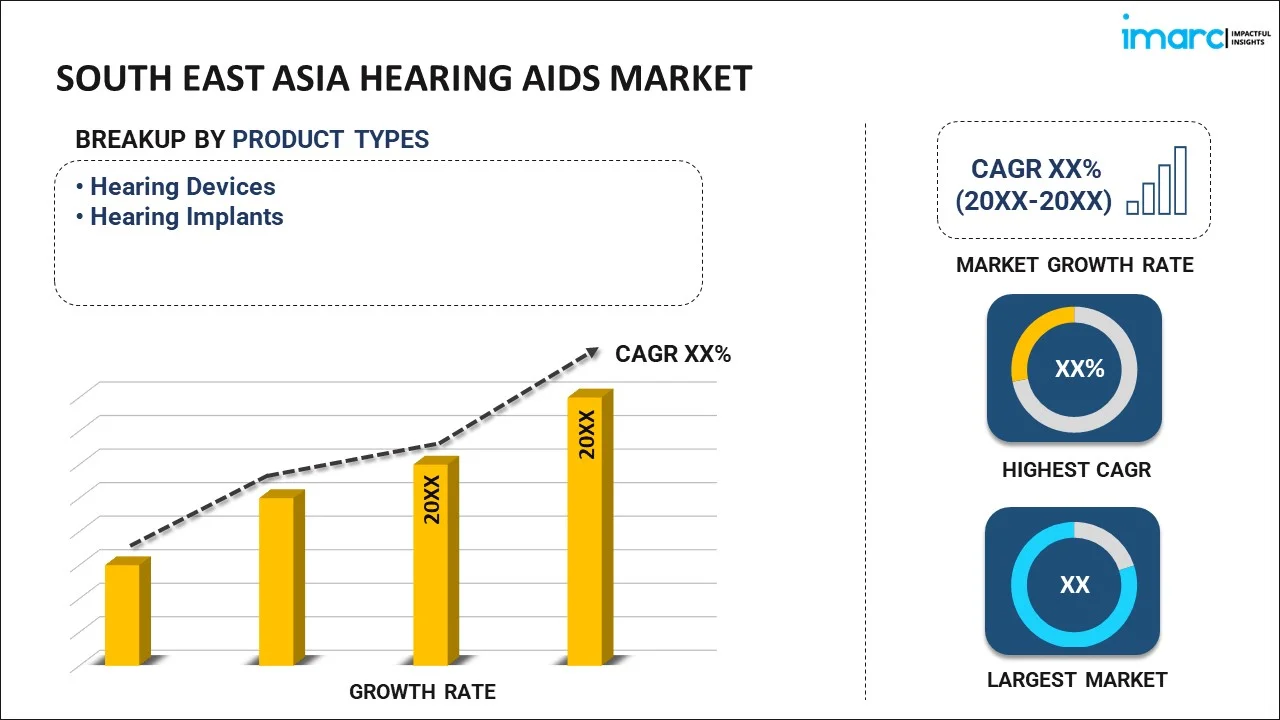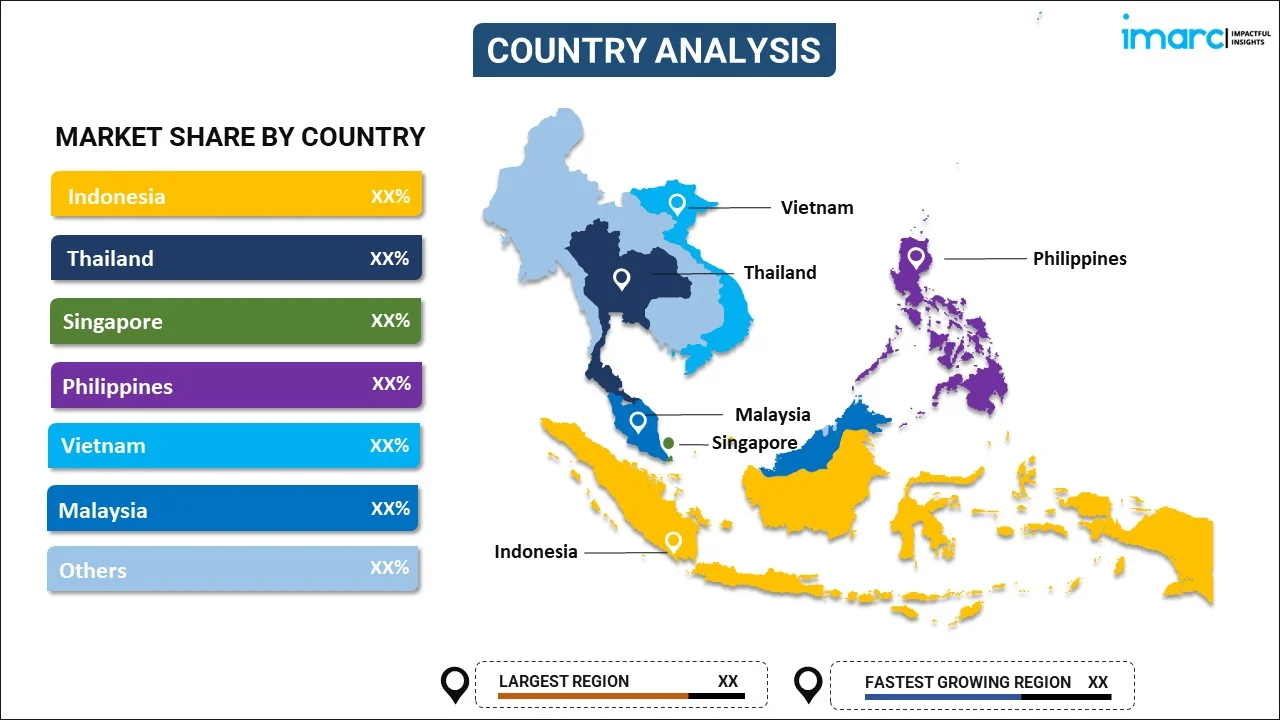
South East Asia Hearing Aids Market Report by Product Type (Hearing Devices, Hearing Implants), Hearing Loss (Sensorineural Hearing Loss, Conductive Hearing Loss), Patient Type (Adults, Pediatrics), Technology Type (Analog, Digital), End User (Hospitals, ENT Clinics and Audiology Centers, Individual, and Others), and Country 2025-2033
Market Overview:
South East Asia hearing aids market size is projected to exhibit a growth rate (CAGR) of 8.84% during 2025-2033. Improving healthcare infrastructures, along with the extensive investments in R&D activities, are primarily driving the market growth.
|
Report Attribute
|
Key Statistics
|
|---|---|
|
Base Year
|
2024 |
|
Forecast Years
|
2025-2033 |
|
Historical Years
|
2019-2024
|
| Market Growth Rate (2025-2033) | 8.84% |
A hearing aid is a compact and battery-operated electronic device utilized to enhance auditory perception, commonly worn either in or behind the ear. Its primary function is to amplify external sounds, enabling individuals with impaired hearing to engage in daily activities, communicate effectively, and participate in various social interactions. Comprising an amplifier, microphone, and speaker, the hearing aid works by intensifying sound vibrations as they enter the ear, amplifying them into larger vibrations, and subsequently converting them into neural signals that are transmitted to the brain. These devices are available in a diverse array of designs and can be tailored to meet the specific needs of the user. For instance, the device may incorporate either analog or digital technology to amplify sound, and it may include earpieces or earmolds designed to direct the flow of soundwaves, thereby enhancing the overall output quality.
South East Asia Hearing Aids Market Trends:
The South East Asia hearing aids market is witnessing significant growth, primarily propelled by the mounting population of elderly individuals. The elderly demographic frequently experiences gradual hearing impairment, leading to an increased demand for hearing aid products within this segment of the population. Additionally, there has been a notable rise in the prevalence of hearing disabilities among the general populace. A considerable number of cases, particularly among infants, remain untreated, subsequently leading to various psychological and speech-related impairments. Moreover, the introduction of visually appealing designs, alongside the launch of innovative product variants like waterproof hearing aids, is further contributing to the expansion of the market. The integration of digital technology, along with the introduction of products that amalgamate cochlear implant and hearing aid technology to address high-frequency hearing loss, is anticipated to generate a positive market outlook. Other contributing factors include the escalating levels of noise pollution, an increase in instances of birth complications and ear infections, the continual rise in disposable income levels, and a heightened focus on research and development (R&D) activities by manufacturers, will collectively drive the growth of the market within the South East Asia region in the coming years.
South East Asia Hearing Aids Market Segmentation:
IMARC Group provides an analysis of the key trends in each segment of the market, along with forecasts at the regional and country levels for 2025-2033. Our report has categorized the market based on product type, hearing loss, patient type, technology type, and end user.
Product Type Insights:

- Hearing Devices
- Behind-the-Ear (BTE)
- Receiver-in-the Ear (RITE)
- In-the-Ear (ITE)
- Canal Hearing Aids (CHA)
- Others
- Hearing Implants
- Cochlear Implants
- BAHA Implants
The report has provided a detailed breakup and analysis of the market based on the product type. This includes hearing devices (behind-the-ear (BTE), receiver-in-the ear (RITE), in-the-ear (ITE), canal hearing aids (CHA), and others) and hearing implants (cochlear implants and BAHA implants).
Hearing Loss Insights:
- Sensorineural Hearing Loss
- Conductive Hearing Loss
A detailed breakup and analysis of the market based on the hearing loss have also been provided in the report. This includes sensorineural hearing loss and conductive hearing loss.
Patient Type Insights:
- Adults
- Pediatrics
The report has provided a detailed breakup and analysis of the market based on the patient type. This includes adults and pediatrics.
Technology Type Insights:
- Analog
- Digital
A detailed breakup and analysis of the market based on the technology type have also been provided in the report. This includes analog and digital.
End User Insights:
- Hospitals
- ENT Clinics and Audiology Centers
- Individual
- Others
The report has provided a detailed breakup and analysis of the market based on the end user. This includes hospitals, ENT clinics and audiology centers, individual, and others.
Country Insights:

- Indonesia
- Thailand
- Singapore
- Philippines
- Vietnam
- Malaysia
- Others
The report has also provided a comprehensive analysis of all the major regional markets, which include Indonesia, Thailand, Singapore, Philippines, Vietnam, Malaysia, and Others.
Competitive Landscape:
The market research report has also provided a comprehensive analysis of the competitive landscape. Competitive analysis such as market structure, key player positioning, top winning strategies, competitive dashboard, and company evaluation quadrant has been covered in the report. Also, detailed profiles of all major companies have been provided.
South East Asia Hearing Aids Market Report Coverage:
| Report Features | Details |
|---|---|
| Base Year of the Analysis | 2024 |
| Historical Period | 2019-2024 |
| Forecast Period | 2025-2033 |
| Units | Billion USD |
| Scope of the Report | Exploration of Historical Trends and Market Outlook, Industry Catalysts and Challenges, Segment-Wise Historical and Future Market Assessment:
|
| Product Types Covered |
|
| Hearing Losses Covered | Sensorineural Hearing Loss, Conductive Hearing Loss |
| Patient Types Covered | Adults, Pediatrics |
| Technology Types Covered | Analog, Digital |
| End Users Covered | Hospitals, ENT Clinics and Audiology Centers, Individual, Others |
| Countries Covered | Indonesia, Thailand, Singapore, Philippines, Vietnam, Malaysia, Others |
| Customization Scope | 10% Free Customization |
| Post-Sale Analyst Support | 10-12 Weeks |
| Delivery Format | PDF and Excel through Email (We can also provide the editable version of the report in PPT/Word format on special request) |
Key Questions Answered in This Report:
- How has the South East Asia hearing aids market performed so far and how will it perform in the coming years?
- What has been the impact of COVID-19 on the South East Asia hearing aids market?
- What is the breakup of the South East Asia hearing aids market on the basis of product type?
- What is the breakup of the South East Asia hearing aids market on the basis of hearing loss?
- What is the breakup of the South East Asia hearing aids market on the basis of patient type?
- What is the breakup of the South East Asia hearing aids market on the basis of technology type?
- What is the breakup of the South East Asia hearing aids market on the basis of end user?
- What are the various stages in the value chain of the South East Asia hearing aids market?
- What are the key driving factors and challenges in the South East Asia hearing aids?
- What is the structure of the South East Asia hearing aids market and who are the key players?
- What is the degree of competition in the South East Asia hearing aids market?
Key Benefits for Stakeholders:
- IMARC’s industry report offers a comprehensive quantitative analysis of various market segments, historical and current market trends, market forecasts, and dynamics of the South East Asia hearing aids market from 2019-2033.
- The research report provides the latest information on the market drivers, challenges, and opportunities in the South East Asia hearing aids market.
- Porter's five forces analysis assist stakeholders in assessing the impact of new entrants, competitive rivalry, supplier power, buyer power, and the threat of substitution. It helps stakeholders to analyze the level of competition within the South East Asia hearing aids industry and its attractiveness.
- Competitive landscape allows stakeholders to understand their competitive environment and provides an insight into the current positions of key players in the market.
Need more help?
- Speak to our experienced analysts for insights on the current market scenarios.
- Include additional segments and countries to customize the report as per your requirement.
- Gain an unparalleled competitive advantage in your domain by understanding how to utilize the report and positively impacting your operations and revenue.
- For further assistance, please connect with our analysts.
 Inquire Before Buying
Inquire Before Buying
 Speak to an Analyst
Speak to an Analyst
 Request Brochure
Request Brochure
 Request Customization
Request Customization




.webp)




.webp)












